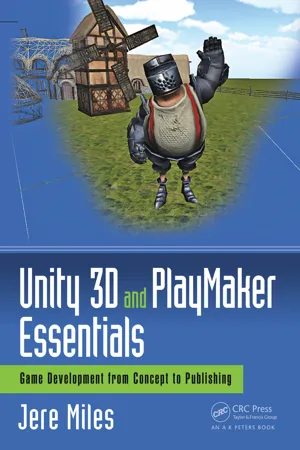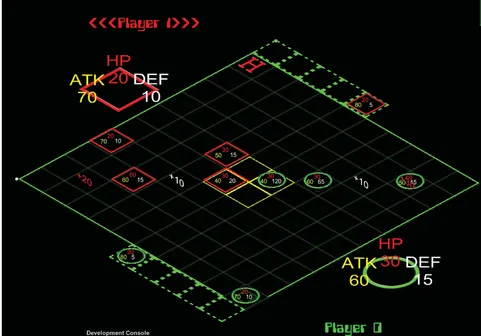![]() SECTION II
SECTION II
Building Blocks![]()
CHAPTER 4
Characters
Now that we have some solid concepts on game development under our belts, we are going to start laying the foundation for our game. Characters play a pivotal role in some games. However, as we will shortly discuss, not all games rely on characters. For our project at hand, we are going to need to understand characters, after all the game does star Sancho Panza, in order to better design our player character and any others that may appear during the game. Even if you are building a puzzle or strategy game, see Chapter 1 for a discussion of these different genres, characters can play an intriguing role by providing a context for the game, not that this is necessary, but it is an option to consider. If you are considering building a role-playing or story-driven game, then the characters will be vital to your project. There is a tremendous overlap between characters and stories which will cause the next chapters to blur together in some aspects. In this chapter, we will explore the following concepts as they pertain to characters and video games.
- Purpose of Characters
- Do Games Need Characters?
- Traditional Character Types
- Game Character Types
- Character Development
- Character Design
- Importing Models in Unity
- Character Control System in PlayMaker
4.1 The Purpose of Characters
Characters provide us, as the audience, with a reference within the story. The characters that we develop for our audience become the perspective that our audience experiences things through or with. Characters also provide a means for distributing information, usually to other characters and therefore to the audience indirectly, although it could be direct through the breaking of the concept of the fourth wall. The characters of a story allow the audience to explore the questions and dilemmas of the story from a safe vantage point; for instance, I may enjoy exploring the depths of human bonding and loyalty through war movies such as Band of Brothers, however, that does not mean that I have any interest in actually serving during the frigid nights of the Battle of the Bulge of World War II. Stories cannot exist without characters; they are the framework that the story hangs upon. After creating characters, we can develop stories by throwing our characters into interesting situations and exploring various questions of morality or friendship or just aspects of being alive. It is through the implementation of characters within a story that we can create tension and emotional connectedness.
4.2 Do Games Need Characters?
The short answer to this question is “No, games do not need characters in them.” We can create many great and fun games that do not contain any characters. Games of chance or strategy can be created with no characters within the game and also with essentially no story to the game. Consider many of the board games that you may play, the only characters within those games are the human players themselves. Consider the exciting strategy game Clear Tactic (Figure 4.1), developed by Enlitanment Studios. While this game does not provide characters in this traditional sense, it still provides a fun and challenging game-play experience with a high replay value. In fact, a strong argument could be made that games can have higher replay values without characters due to an increase in the flexibility of the game-play experience. Through playing a game such as Clear Tactic, the traditional roles of characters, specifically the hero and shadow as we will discuss shortly, is taken on by the human players themselves. This makes the game-play experience dynamic and different each time that the game is played.
We need to pause for a moment to differentiate between avatar and character. An avatar in a game is a physical representation of a player. For instance, the player piece that you may select for a game of Monopoly is your avatar on the board, this is not a character. A character, on the other hand, may incorporate an avatar for the player, but more than that in order to be a character it must contain its own goals and motivations within the game. Consider a computer-based role-playing game (CRPG), as game developers, we need to provide a customizable avatar for the player to represent themselves within the game world and we must provide a flexible story for the player to interact with; however, the player’s motivations for doing what they do will be entirely defined by the player themselves, within the confines that we provide inside of the story. On the other hand, if we create a third-person shooter in which the player plays the role of a SWAT team member fighting crime in some fictional city, we as the game developers have created a character and avatar for the player, why the player is doing what they are doing is defined by the motivations and desires of the character that we have created. This may be a subtle distinction, but it is very important for us to grasp. Video games must have some form of avatar to represent the player within the game world, the moveable pieces from Enlitanment Studio’s Clear Tactic for instance, but they do not need to contain characters, unless we require characters because of the story that we wish to tell through the game-play experience.
FIG 4.1 Clear Tactic by Enlitanment Studios as played on Facebook.
4.3 Traditional Character Types
Through the history of storytelling and drama, a rich heritage of character types has developed. While it is not necessary for each game, or indeed even any game, to contain all of these different characters, it is nice to know what we have available to us in the traditional arsenal, especially when we get into creating stories. Over the years, many people have studied the traditional stories that societies tell looking at how they are constructed and the characters that appear within them. A full book could easily be dedicated to a solid study of characters and character development, both in and out of games. As an introduction to this topic, however, we have selected the character types developed by Christopher Vogler in his work The Writer’s Journey: Mythic Structures for Writers.
A little background is in order before going on into the character archetypes. Christopher Vogler’s work was developed as a blueprint for the adaption of Joseph Campbell’s The Hero with a Thousand Faces to the creation of screen writing. Joseph Campbell spent most of his life studying mythology from all cultures and utilized the theories of Carl Jung and Sigmund Freud in his analysis of these legends and myths. Over the course of this study, he began to notice a certain pattern emerging. This pattern would go on to become known as the hero’s journey or journey of the hero. We will look at this pattern in more detail in the next chapters as it specifically pertains to stories and the events within a story. But, for now, what we are interested in is that Joseph Campbell noticed that within this hero’s journey, there were specific character types needed to fulfill specific roles, and Christopher Vogler has provided a solid guideline for the use of these character archetypes. Throughout the following discussion on the character archetypes, we will reference the classic work The Lord of the Rings by J.R.R. Tolkien as an example of these character types in action. This particular story was created prior to the work of Joseph Campbell and yet because Tolkien was a scholar of old English and Nordic legends, his characters incorporate the same archetypes. Table 4.1 displays an overview of the character types that we will be looking at.
TABLE 4.1 Christopher Vogler’s Character Archetypes and Examples from The Lord of the Rings
| Archetype | Story Purpose | Example |
| Hero | Protagonist, main character of the story | Frodo |
| Shadow | Antagonist, main villain of the story | Sauron |
| Mentor | Trainer and teacher for the hero | Aragorn |
| Ally | Helper and assistant to the hero | Samwise |
| Herald | Beacon pointing the hero in the correct direction | Gandalf |
| Trickster | Comic relief and general mischief | Mariadoc and Peregrin |
| Threshold Guardian | Obstacle before the hero can pass into new knowledge | Shelob, among others |
| Shapeshifter | Character with seemingly changing loyalties and views | Gollum |
4.3.1 The Hero
Every story must have a central character, a primary and pivotal character around which the whole story revolves. It is through this central character that the audience will experience the story. Not only will the audience experience the story through this character, but the audience will also perceive the story through this character. This central character is the hero of the story. In a video game, the hero is also the player character; after all, very few of us would want to play a video game in which we were not the pivotal character of the game, though this may be an interesting concept to incorporate into a game idea. A traditional view of the hero character is a character that has a willingness to protect others that are not able to protect themselves. This protection provided by the hero character may even involve the sacrifice of the character in some way. However, the game industry has begun to experiment with this model by casting the main character of the game in a morally ambiguous context. While the exploration of morality within a story and game experience is an exciting opportunity for us to explore, keep in mind that in order to follow these classic models of storytelling, the hero should follow those more traditional guidelines.
The hero for The Lord of the Rings is Frodo Baggins. He was a typical Hobbit that could so easily be identified with by the audience even though the audience did not actually consist of any Hobbits. He cared for the other Hobbits and Middle Earth in general but would much prefer to be left alone. However, his character is such that he is willing to do what must be done to protect those that cannot protect themselves, to the ultimate willingness of sacrificing himself if it were to become necessary.
4.3.2 The Shadow
The opposite of the hero is the shadow character. It is the job of the shado...

